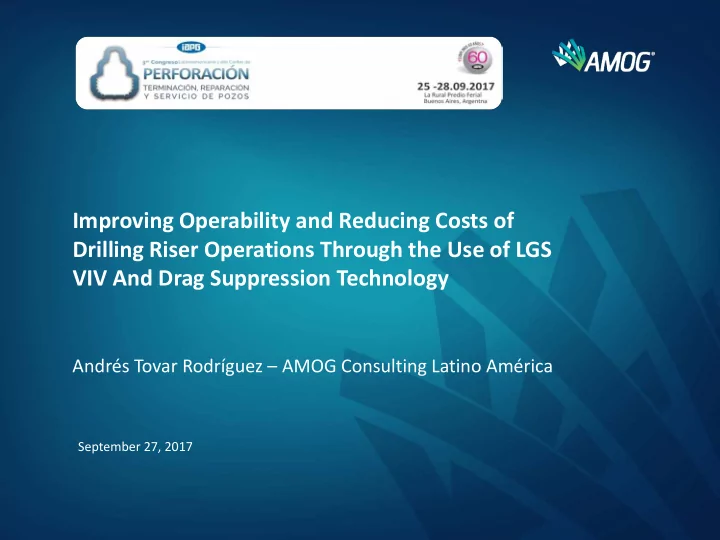

Improving Operability and Reducing Costs of Drilling Riser Operations Through the Use of LGS VIV And Drag Suppression Technology Andrés Tovar Rodríguez – AMOG Consulting Latino América September 27, 2017
Vortex-Induced Vibration - VIV A significant challenge for offshore oil and gas globally Shedding frequency Vortices shed Vortex similar to a by cylindrical Induced natural body Vibrations frequency of the structure
Effect on offshore infrastructure VIV affects many types of offshore infrastructure Effects include: • Fatigue Damage • Amplified Drag • Impacts on operability Deeper water increases the risk
Impact on drilling risers Drill string can only operate with a low curvature in the riser In strong currents, VIV amplifies the drag on the riser, and deflections become unacceptable Fatigue damage can accumulate quickly Significant cost implications – projects have been postponed for years as a result
Drilling Riser Buoyancy Modules Deepwater drilling risers are covered with DRBMs to lower the top tension DRBMs must: • Maximize cross sectional area (maximum buoyancy) • Fit through the limited space available in the drill floor Image: Trelleborg 2017
Traditional VIV Suppression Helical Strakes: • Used throughout the offshore industry to suppress VIV • Almost completely eliminate VIV • Increase drag • Not suitable for DRBMs due to loss of buoyancy Image: Trelleborg 2017
Traditional VIV Suppression DRBMs requiring VIV suppression typically use fairings Fairings must rotate to align with the current direction Fairings can: • Lock, or fail to rotate (performance is unknown) • Fall off (up to 20% of fairings) Image: Matrix Composites & Engineering
Traditional VIV Suppression Fairings require significant additional time to install Impacts: • Additional risk to installation personnel • Additional time paying spread rates • Reduced ability to quickly retrieve and run from a storm Image: Matrix Composites & Engineering
Longitudinally Grooved Suppression A new VIV suppression technology that can be integrated into DRBMs Balances competing requirements: • VIV suppression • Low drag • Maximum buoyancy • Ease of use Image: Matrix Composites & Engineering
LGS Development Inspired by the Saguaro cactus, which has evolved a low drag shape to withstand strong winds Image: Matrix Composites & Engineering Image: Hillhaus
LGS Development Small Scale Large Scale • Rapid prototyping • Performance under realistic conditions • Measured performance • Selection of best geometries Images: AMOG
LGS Performance Drag VIV Amplitude 1 1 0,9 0,9 0,8 0,8 0,7 0,7 0,6 0,6 0,5 0,5 0,4 0,4 0,3 0,3 0,2 0,2 0,1 0,1 0 0 Bare Cylinder LGS Bare Cylinder LGS
South American Currents South American offshore currents can include significant counter currents at depth VIV suppression may be required at both Water Depth the top and the bottom of the riser The effect of LGS had not previously been studied in counter currents Current Speed
0 Current Profiles 250 Current profiles used in the Water Depth (m) 500 analysis: • Both extreme and long term 750 currents 1000 • With and without counter currents 1250 1500 -1 -0,5 0 0,5 1 1,5 2 Current Speed (m/s) Long Term Current Long Term Current with Countercurrent Extreme Current Extreme Current with Countercurrent
Riser Arrangements
Analysis Method LGS does not behave like a bare cylinder: • Drag amplification, • Vibration behavior and • Vibration frequency • Are all different A customized version of SHEAR7 was used for the analysis
Results – Long Term Current 0 0 200 200 400 400 Water Depth (m) Water Depth (m) 600 600 800 800 1000 1000 1200 1200 1400 1400 1600 1600 0 2 4 6 8 10 -8 -6 -4 -2 0 2 Riser Offset (m) Riser Offset (m) LGS Conventional Fairings LGS Conventional Fairings Without counter current With counter current
Results – Extreme Currents 0 0 200 200 400 400 Water Depth (m) 600 Water Depth (m) 600 800 800 1000 1000 1200 1200 1400 1400 1600 1600 0 5 10 15 20 25 30 -2 2 6 10 14 18 Riser Offset (m) Riser Offset (m) LGS Conventional Fairings LGS Conventional Fairings Without counter current With counter current
Results – Top Angles Top angle in Conventional Fairings LGS Degrees Long Term Current 1.6 1.3 1.0 Long Term Current 0.6 0.5 0.4 with Countercurrent Extreme Current 6.6 4.1 4.3 Extreme Current 5.3 3.4 3.5 with Countercurrent
Results – Fatigue Life Fatigue Life in Years Conventional Fairings LGS Long Term Current 65.5 267 2461 Long Term Current 30.9 80.4 1812 with Countercurrent Extreme Current 2.35 33.9 93.6 Extreme Current 3.59 24.8 19.2 with Countercurrent
Conclusions When strong currents exist at depth, VIV suppression over the entire length of the riser is advantageous This cannot be practically achieved with fairings LGS provides VIV suppression which will be effective in all current conditions This performance is achieved without any additional handling time LGS not subject to mechanical failure as with fairings
Conclusions Model testing and computational simulations have shown the predicted benefits of LGS Validation via instrumented riser is underway Preliminary results indicate performance as expected Image: Matrix Composites & Engineering
Acknowledgements AMOG would like to thank Matrix Composites & Engineering Pty Ltd for their support of the high Reynolds number testing and field trials of LGS. LGS is a registered trademark of AMOG Technologies Pty Ltd and has patents pending. LGS is manufactured under license by Matrix Composites & Engineering Image: Matrix Composites & Engineering
Recommend
More recommend